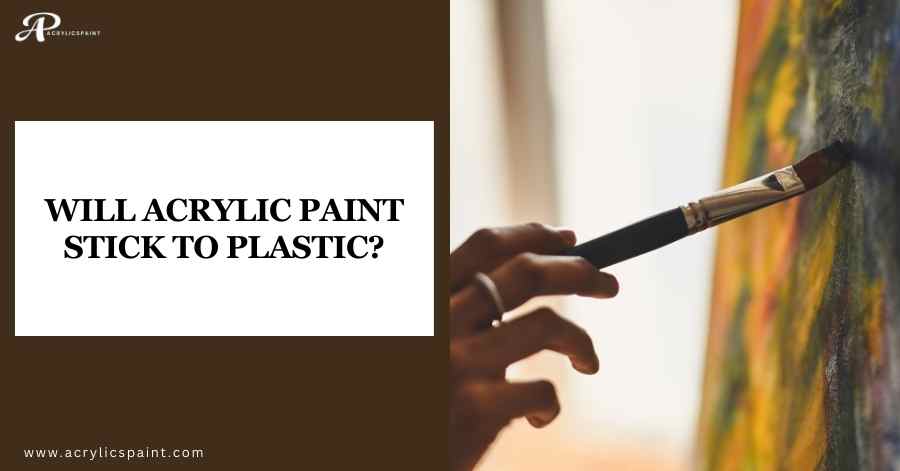Acrylic paint sticks to plastic – Have you ever looked at a plain plastic object and envisioned it transformed into a vibrant masterpiece? While acrylic paint is a popular and simple choice for various surfaces, its affinity with Plastic can be tricky. Fear not, creative minds! This blog post will help you with how to keep paint on Plastic for a longer run, exploring the factors that affect adhesion and providing valuable tips for a successful artistic endeavor.
Can You Paint on Acrylic Plastic?
The answer is more than a simple yes or no. While acrylic paint can technically adhere to some types of Plastic, its success heavily relies on its composition. Here’s what you need to know:
Types of Plastic
Certain plastics, like polypropylene (PP) and polyethylene (PE), have a non-porous surface that repels paint. Acrylics won’t stick well to these materials. On the other hand, plastics like polystyrene (PS) and acrylonitrile butadiene styrene (ABS) are more receptive to paint adhesion.
Surface Preparation is Key
Proper surface preparation is important even when using compatible plastics. This requires cleaning the Plastic with soap and water to remove dirt, grease, or oils that may prevent paint adhesion. You can also use a light abrasive pad to improve the paint’s grip and create a slightly rough surface.
Step-by-Step Guide on How to Make Acrylic Paint Sticks to Plastic
Now that you understand the factors at play let’s explore the steps to ensure your acrylic paint masterpiece stays put:
- Identify the Plastic Type: Look for a recycling symbol on the plastic object. Numbers 1, 5, and 6 usually indicate PS or ABS, which are more compatible with acrylics.
- Clean the Plastic Thoroughly: Wash the plastic item with warm water and dish soap, removing any residues that could affect adhesion.
- Light Sanding (Optional): Use fine-grit sandpaper to scuff the plastic surface for extra grip gently. Wipe away dust with a damp cloth.
- Priming (Highly Recommended): Apply a coat of a plastic-specific primer. This creates a stronger bond between the Plastic and the paint. Let the primer dry for best results.
- Apply Acrylic Paint: For best results, use high-quality acrylic paints. Apply thin layers of paint and let them dry. Water-based acrylics dry quickly, while oil-based paints take longer. Add the other layers and create your artwork.
- Seal the Paint (Optional but Recommended): After your final coat of paint dries, consider applying a coat of clear acrylic sealer to provide additional protection and durability for your painted plastic creation.
Eco-Friendly Tip: Look for acrylic paints labeled “eco-friendly” or “non-toxic” for a more environmentally conscious approach.
How to Paint on Acrylic Plastic
- Surface Preparation: Clean the plastic surface thoroughly to remove any dirt, grease, or debris that could interfere with paint adhesion. Use soap and water or a mild detergent to clean the surface.
- Priming: Apply a thin, even coat of plastic primer to the surface using a brush or spray. The primer must dry completely, according to the instructions, before proceeding.
- Painting: After the primer dries, you can begin painting with acrylic mediums. Use high-quality acrylic paint and apply multiple thin coats for best results.
- Sealing: After the paint has dried completely, it’s essential to seal the surface to protect the paint and enhance its longevity. Use a clear acrylic sealer or varnish specifically formulated for acrylic paints. Apply the sealer in thin, even coats.
Primer for Acrylic Paint on Plastic
Before painting plastic with acrylic paint, it’s crucial to use a primer made for plastic surfaces. A plastic primer creates a suitable surface for the paint to stick to it for better coverage and longevity. Apply the primer evenly to the plastic surface and allow it to dry completely. After that, you can begin your painting.
Sealing Acrylic Paint on Plastic
Sealing acrylic paint on Plastic is crucial to prevent chipping, fading, or peeling over time. A clear acrylic sealer creates a protective barrier over the painted surface, safeguarding it against environmental factors and everyday wear and tear. Make sure to choose a sealer that is compatible with acrylic paints and suitable for use on plastic surfaces to make it water resistant.
Alternatives to Acrylic Paint for Plastic
While acrylic paint can work on certain plastics with proper preparation, here are some additional options to consider:
Enamel Paint
While acrylic paint is suitable for painting on plastic, enamel paint is another option. Enamel paint adheres well to plastic surfaces and provides a durable finish. However, compared to acrylics, enamel paint requires additional precautions, such as proper ventilation and longer drying times.
Spray Paint
Certain spray paints are formulated specifically for Plastic. Look for brands that mention “can be used on plastic” on the label. Remember: Always test your chosen paint and primer on a small, inconspicuous area of the plastic object before committing to the entire project. This helps you assess the adhesive properties of paint before diving in.
Eco-Friendly Acrylic Paint
When choosing acrylic paint for your plastic surface, consider opting for eco-friendly options that are water-based and non-toxic. These paints are safer for the environment and your health, making them a preferable choice for conscious artists and hobbyists.
Conclusion
In conclusion, Acrylic Paint sticks to Plastic can adhere to plastic surfaces effectively when proper preparation and sealing techniques are employed. You can achieve beautiful and durable results on acrylic plastic by using a plastic primer, applying multiple thin coats of acrylic paint, and sealing the finished artwork with a clear acrylic sealer.
Remember to choose eco-friendly paints and consider alternative options like enamel paint for specific projects. With the right materials and techniques, you can unleash your creativity and transform plastic surfaces into stunning works of art. By following these tips and understanding the science behind paint adhesion, you can transform ordinary plastic objects into extraordinary works of art with the vibrant world of acrylic paints!













